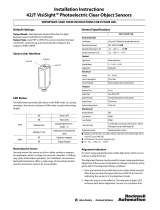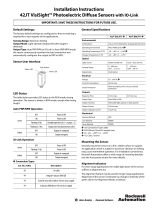Page is loading ...

Installation Instructions
42JT VisiSight™ Photoelectric Clear Object Sensors with IO-Link
IMPORTANT: SAVE THESE INSTRUCTIONS FOR FUTURE USE.
Default Settings:
Output Mode: Dark Operate (Output ON when the light between
sensor and reflector is blocked)
Output Type: Auto PNP/NPN or IO-Link. In Auto PNP/NPN mode,
the sensor continuously monitors the load connection and
automatically configures the output to PNP or NPN.
Sensor User Interface
LED Status
The table below provides LED status in the RUN mode. During
operation, the sensor is always in RUN mode, except when being
taught.
Auto PNP/NPN Operation
IO-Link Operation
Green
OFF Power is OFF
ON Power is ON
Flashing (6 Hz) Unstable light level (0.5 < margin < 2)
Flashing (1.5 Hz) Output short circuit protection active
Yel lo w
OFF Output de-energized
ON Output energized
Green
OFF Power is OFF
Flashing (1 Hz) Power is ON
Yel lo w
OFF Output de-energized
ON Output energized
Yellow LED
Pushbutton
Green LED
General Specifications
See Connection Types table.
ECOLAB on P4 and A2 models only
UL: -20…+50°C (-4…122°F)
UL: Class 2 source
Connection Types
42JT-C2LAT1-
Environmental
Certifications cULus and CE Marked for all applicable directives
Operating Environment IP67, IP69K, ECOLAB
Operating Temperature [C (F)] -20…+60° (-4…+140°)
Storage Temperature [C (F)] -20…+80° (-4…+179°)
Optical
Light Source Visible red 660 nm
Sensing Range 0…2 m (0…6.6 ft)
Adjustments Push button
Electrical
Voltage 10…30V DC
Current Consumption 30 mA max.
Sensor Protection Reverse polarity, short circuit protection
Outputs
Response Time 0.5 ms
Output Type Auto NPN or PNP
Output Function Selectable light operate or dark operate
Output Current 100 mA max.
Output Leakage Current 10 μA max.
Mechanical
Housing Material ABS
Lens Material PMMA
Cover Material PMMA
Optional Accessories Mounting brackets, cordsets
Cat. No. Suffix Description
-A2 2 m cable (PUR)
-P4 Integral 4-pin pico (M8) QD
-F4 4-pin DC micro (M12) QD on 150 mm (6in.) pigtail
-Y4 4-pin pico (M8) QD on 150 mm (6 in.) pigtail

2
Mounting the Sensor
Securely mount the sensor on a firm, stable surface or support. An
application which is subject to excessive vibration or shifting may
cause intermittent operation. For installation convenience,
Rockwell Automation offers a wide range of mounting brackets
(see the Accessories section for more details).
Alignment Indication
For short range applications the visible light beam of the sensor
suffices as alignment aid.
The alignment feature may be used for longer range applications.
Alignment of the sensor is indicated by a change in intensity of
the green LED in the Alignment Mode, as follows:
1. Press and release the push button twice within three seconds.
After three seconds, the green LED turns OFF for 0.5 second,
indicating that the sensor is in the alignment mode.
2. Align the sensor to the reflector. The intensity of green LED
increases with better alignment. Secure it in the position that
yields the highest intensity of the green LED. Press and release
the button once to return to the RUN mode—or the sensor
returns to the RUN mode automatically in two minutes.
VisiSight™ Configuration
The 42JT VisiSight is configured using the push button, Remote
Teach, or via IO-Link and the LED indicators on the sensor. The five
following features can be configured:
• Static Teach: Standard or Precision Teach for sensitivity/
sensing range
• Dynamic Teach (running process)
• Light operate (LO) or dark operate (DO) output
• Auto PNP/NPN, dedicated NPN or dedicated PNP
• Push button lock/unlock
The sensor output is disabled during Teach.
Teach Sensitivity/Sensing Range
The default setting is the maximum range.
Static Teach:
Teaching the sensitivity/sensing range is a two step process: teach
the reflector (first condition) and teach “target” (second
condition.
Standard Teach:
1. Teach the reflector (first condition)
Align the sensor to the reflector. Press and hold button
for three seconds until the yellow LED starts flashing.
Release the button. The first condition has now been
taught.
t > 3 s
Reflector
2. Teach target (second condition):
The sensor can also be taught by teaching the target as the
first condition and the reflector as the second condition.
Precision Teach:
A precision teach can be performed by teaching the reflector as
both the first and second condition, i.e. clear target is not taught.
This sets the sensor to its highest sensitivity to detect very clear
targets. Under this setting, a small change in signal received will
switch the output.
Restore to factory default setting of maximum range:
Perform steps 1 and 2 with no reflector and no target in the
sensor field of view.
Dynamic Teach (Running Process):
If the targets to be detected are moving with the sensor aimed at
the running process, press and hold the button for three seconds
until the yellow LED starts flashing. The sensitivity will
automatically be taught in the next 30 seconds, provided the
sensor sees two cycles of “target” and “no target.”
Teach Light Operate (LO) or Dark Operate (DO)
The default setting of the output is Dark Operate (DO).
DO setting means that the output turns ON when the target is
detected. If the application requires the output to turn OFF when
the target is detected, the setting may be changed to Light
Operate (LO).
1. To access the teach output mode setting:
2. To change the sensor output mode setting:
Position the clearest target to be detected between the
sensor and the reflector. Press and release the button.
The teach process is complete.
If the push button is not pressed within 30 seconds, the
sensor exits the teaching mode and returns to RUN mode
without learning a new setting.
Press and hold button for six seconds until green LED
starts flashing. Release the button. The current setting is
indicated by the yellow LED:
LO: Yellow LED ON
DO: Yellow LED OFF
Press and release the button within ten seconds to
toggle—from LO to DO—the selection indicated by the
yellow LED.
The sensor retains the setting configured by the last
button activation and returns to the RUN mode ten
seconds after the last button is depressed.
t < 0.5 s
Reflector
t > 6 s
t < 0.5 s

3
Output Type Selection:
Auto PNP/NPN, Dedicated NPN, Dedicated PNP)
The default setting is Auto PNP/NPN. This means the sensor
monitors the load connection and automatically configures for
the proper operation, namely PNP or NPN. If no load is connected,
the sensor defaults to PNP.
The following applications are covered with dedicated PNP or
dedicated NPN selection:
a. Parallel wiring of multiple sensor outputs: select dedicated
PNP or dedicated NPN setting, as needed.
b. If the load is connected for NPN configuration but to a
different power supply than the power to the sensor or via a
load enabling contact (e.g., a relay contact in series with the
load): select dedicated NPN.
Perform a selection as follows:
1. To access output type: Press and hold the push button for 12
seconds (until both LEDs start flashing synchronously). Upon
button release, the current setting of output type is indicated
by the slow flashing of the LED (or LEDs) as follows:
• Auto PNP/NPN: both LEDs flashing
• Dedicated NPN: green LED flashing
• Dedicated PNP: yellow LED flashing
2. To change output type: Press and release the push button
within ten seconds to select desired type. Each activation of
the button will cycle to the next output setting. The type
selected is indicated by the LEDs. The sensor retains the setting
configured by the last button activation and returns to the RUN
mode ten seconds after the last button is pressed.
Push Button Lock/Unlock
The push button or remote teach (RT) can be used to prevent
unauthorized users from changing teach settings.
To lock the push button: press and release the button three
times within three seconds. Both LEDs flash synchronously for
three seconds, indicating that the push button is now locked.
To unlock the push button: press and release the button three
times within three seconds. Both LEDs flash asynchronously for
three seconds, indicating that the push button is now unlocked.
Permanent Lock: The push button may be permanently locked
by connecting the white wire (pin 2) to –V.
Remote Teach (RT)
The sensor can be taught remotely via the white wire (pin 2).
Connection to +V produces the same result as a button activation,
while no connection is equivalent to not pressing the button.
The sensor can be taught by following the same teach/timing
sequence as used in the push button teach. For example, connect
to the +V for more than three seconds to align and install the
reflector, disconnect from the +V; while the reflector is in the
sensor field of view and there is no target, connect to the +V for
less than one second to complete the teach process. All push
button functions can also be carried out via RT.
IO-Link
See instructions for IO-Link on www.ab.com/literature. Remote
Teach (pin 2) is disabled in IO-Link operation. If output is selected
as dedicated NPN, IO-Link communication is unavailable.
Wiring Diagrams
The following diagrams show the quick-disconnect connector.
The pin numbers correspond to male connectors on the sensor.
Micro (M12) Male QD on Pigtail and
Integral Pico (M8) Male QD
Output Wiring
Normal operation: no connection (disabled in IO-Link operation).
Remote Teach: connect to +V. Refer to the Remote Teach section.
Push Button Lock: connect to -V. Refer to the Push Button Lock/
Unlock section.
Approximate Dimensions [mm (in.)]
4
3
1
2
3
2
1
4
M12 Male M8 Male
Brown (1)
White (2)
Black (4)
Blue (3)
+V
Remote Teach/Lock
Output (Auto PNP/NPN or IO-Link)
-V
LO
DO
12
(0.47)
M8 x 1
34
(1.34)
22.9
(0.90)
25.4
(1.0)
2.6
(0.10)
20
(0.79)
12
(0.47)
34
(1.34)
22.9
(0.90)
25.4
(1.0)
2.6
(0.10)
20
(0.79)
2.8
(0.11)
Clearance for
M3 or #4-40 screw
(2 places)
Clearance for
M3 or #4-40 screw
(2 places)

Rockwell Automation maintains current product environmental information on its website at
http://www.rockwellautomation.com/rockwellautomation/about-us/sustainability-ethics/product-environmental-compliance.page
.
Publication 42JT-IN006A-EN-P—10000290639 Ver 02—December 2014 Copyright © 2014 Rockwell Automation, Inc. All rights reserved.
Printed in Germany. 068-14550
Spot Size
* The spot size is square in shape with one side dimension per the graph.
Linear increase in spot size to 2 meters.
Accessories
Stainless Steel Mounting Brackets
60-BJS-L1
60-BJT-L2
60-2619 VisiSight-compatible swivel/tilt mounting
bracket
0 0.2
(0.66)
0.4
(1.31)
0.6
(1.97)
0.8
(2.62)
1.0
(3.28)
0
10
20
30
40
Size [mm]*
Distance [m (ft)]
12
(0.47)
18.6
(0.73)
33
(1.3)
14
(0.55)
24
(0.95)
8 (0.32)
15
°
R 25.4
(R 1.0)
30°
20°
63.5
(2.5)
8
(0.32)
14
(0.55)
R 25.4
(1.0)
12
(0.47)
18.6
(0.73)
33
(1.3)
10°
Reflectors
92-118 Micro cube reflector
92-134 Micro cube reflector
This reflector can be used if a smaller size reflector is preferred and
the reflector is mounted within 1 m (3.28 ft) of the sensor.
10 (0.39)
3.5
(0.14)
7.0
(0.28)
20 (0.79)
60.7
(2.39)
51.0
(2.01)
40.0
(1.58)
38.0 (1.50)
51.0 (2.01)
4.3 (0.17)
3.8
(0.1496)
20
(0.79)
20
(0.79)
26
(1.02)
32
(1.26)
3
(0.118)
3.7
(0.146) dia.
/






